Editor's Choice Award
Our Editor's Choice award goes to products that dramatically exceed expectations for performance, value, or cutting-edge design.
- Extremely bright for its price point
- Dynamic Tone Mapping
- 4K/120Hz support
- Import/Export batch settings
- Multiple lens options
- Built-in web interface
- Global light output
- FFTB only available in Dynamic picture mode
- No HDR10+ support
- Limited gamut coverage
- Lens installation requires removal of top
The QL7000 is Epson’s flagship model in the new Q series, designed to fill a gap in the market for high-lumen output projectors at an accessible price point. It is also built to meet the needs of multipurpose rooms, bringing projection beyond the dark spaces traditionally associated with projectors. Capable of illuminating even the largest screens used in home theaters today, the QL7000 further positions Epson as a strong contender in the projection space. It offers a highly versatile solution while maintaining the performance and quality that users have come to expect from Epson.
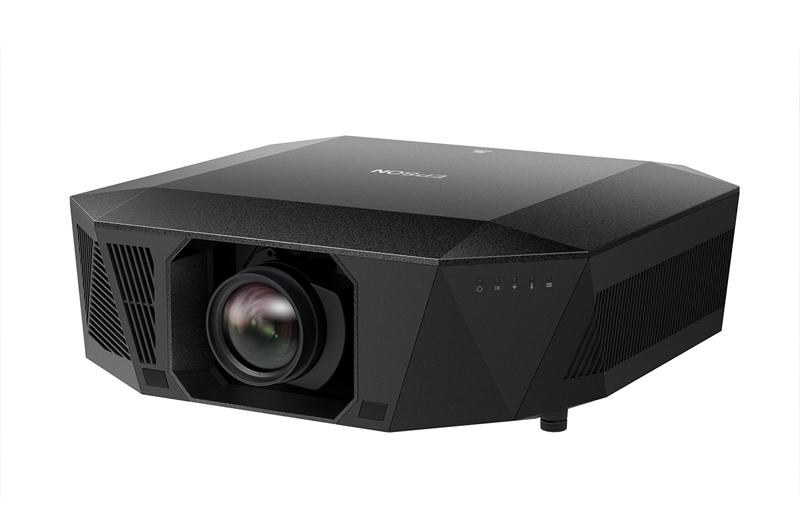
The QL7000 was announced and debuted in September 2024, alongside its siblings, the QL3000 and QB1000, as part of Epson's Q Series 3LCD projectors, which focus on premium high-lumen performance. With the tagline "Reimagine Projection," the QL7000 embodies this concept by taking projection beyond traditional dark theater rooms and into multi-purpose spaces with ambient light.
That's not to say that the QL7000 couldn't be used in a dedicated dark theater; it thrives in that environment as well. However, what sets it apart is its exceptional versatility, offering high-lumen output at a price point where such brightness is uncommon.
In projection, larger screen sizes typically require a more powerful (and often more expensive) projector to achieve proper brightness. Many users find themselves priced out of high-lumen options, sometimes settling for under-powered projectors that struggle to perform. This is where the QL7000—and the QL3000—stand out, delivering the reliable performance users expect from Epson at an outstanding value.
Insights into Our Reviewer's Process
Check out this interview with reviewer Sammie Prescott where we learn more about his process and discuss his review of the Epson QL7000 4K laser projector.
Features
The Epson QL7000 is the flagship model of the Q-Series line of home cinema projectors, released in September 2024 with an MSRP of $29,999. Designed to demonstrate that projection is not limited to the dark theater rooms, the QL7000 drives this point home with its high lumen output and relatively compact size. Compared to other projectors offering similar light output, its smaller form factor, lighter weight, and efficient power requirements provides greater versatility in terms of placement and usage.
The QL7000 boasts an impressive 10,000 ISO lumens, allowing it to properly illuminate massive screen sizes of up to 300 inches diagonally. In our measurements, it not only met but exceeded its lumen specification, registering 10,103 ANSI lumens—1.03% higher than the stated output. This was achieved in the brightest picture mode: Dynamic. Even in other picture modes, the QL7000 maintained an average of approximately 8,250 ANSI lumens, which is highly impressive. The QL7000 offers impressive light output, operating on a standard voltage line without special power needs to reach its full lumen capacity.
Like its siblings in the Q-Series lineup, the QL7000 employs Epson's 3-Chip 3LCD projection engine, which engages three individual LCD chips for red, green, and blue primary colors. This technology has a proven track record of delivering an excellent, vibrant image, and the QL7000 is no exception. Its light source is a Multi-Array Laser Diode solid-state system, offering up to 20,000 hours of operation across Normal, Medium, and Eco modes. Additionally, the QL7000 supports Epson's UltraBlack technology—a proprietary compensation filter designed to work in tandem with the multi-array laser. This filter helps control light polarization, suppress stray light within the optical path, enhance black levels, and improve the overall dynamic contrast of the image. UltraBlack technology is included across all QB and QL-Series models.
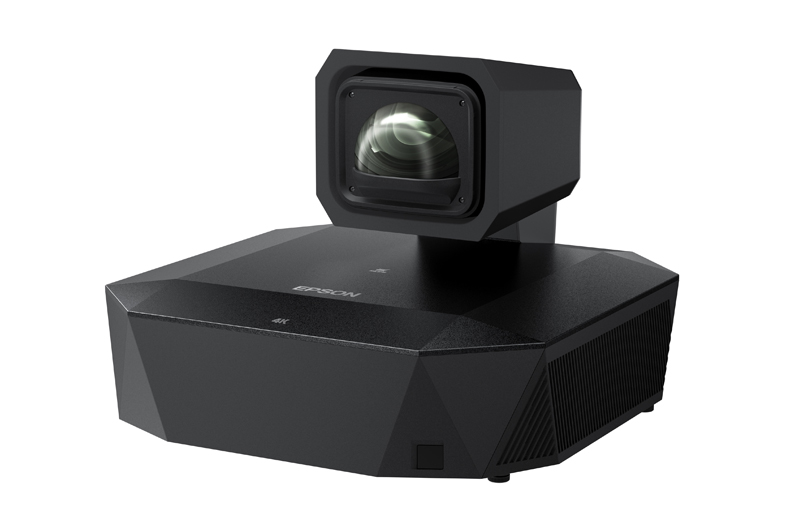
The QL7000 is a 4K UHD projector that employs pixel shifting, a common approach in Epson's lineup. It is capable of resolving the full UHD 4K (3840x2160) resolution, delivering an impressive 8.29 million pixels on-screen with remarkable clarity. Many would be surprised that the QL7000 uses pixel shifting, as its image sharpness was extraordinary. Additionally, the projector's pixel grid is exceptionally fine—barely discernible unless viewed from a distance of approximately two feet or less from the screen.
Additionally, I evaluated the QL7000 using multiple woven screen materials from various brands, including Seymour AV's Neo, XD, and UF materials, as well as Severtson's woven offerings. Across all tested materials, I detected no moiré artifacts. This means that not only does the QL7000 deliver an incredibly sharp image that is nearly indistinguishable from native 4K, but it also produces a clean, artifact-free picture when paired with finely woven projection screens.
One of the QL7000's strongest features is its flexible lens options. Epson's precision lenses, which accommodate ultra-short throw, short-throw, or long-throw configurations, offer a level of versatility that should meet nearly any installation need.
During my review of the QL7000, I used the ELPLW06, a wide-throw zoom lens. The lens's sharpness was impressive, and installation was quick and easy. However, installing the lens requires removal of the top cover on the QL7000 (it ships with the top cover removed). Once the lens is slid into place, a lever is pulled to clamp and secure it.
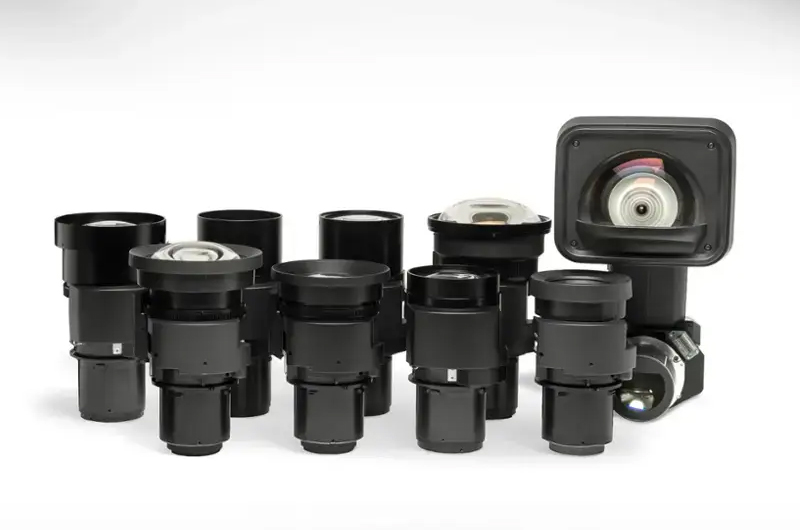
One of my few complaints about the QL7000—largely a personal preference based on experience with various projectors—is the positioning of the lens clamp beneath the top cover. In most projection systems with interchangeable lenses, the lens is secured from the front of the unit, allowing for easy swaps when needed. Since the QL7000's top cover clips into place and can be screwed down at the back, changing a lens requires more effort compared to a front-mounted system.
To be fair, once a lens is installed, there is little reason for a user to switch it out frequently. However, for ease of installation and use, I would have preferred a front-access design that eliminates the need to remove the top cover.
The QL7000 features a sleek, modern design that seamlessly blends into a more welcoming environment. With its low-profile build, it moves away from the bulky and heavy designs typically found in high-lumen projectors. Weighing 46.5 lbs. and measuring 22.4 x 7.5 x 22.4 inches (WHD) without a lens installed, the QL7000 is remarkably compact. Additionally, it operates extremely quietly and offers flexible placement options, thanks to its variety of compatible lenses.
Geometry correction is also available for fine-tuning image alignment. The QL7000 offers a wide range of options, including horizontal and vertical keystone correction, Quick Corner, curved surface adjustment, corner wall correction, and point correction. These features provide extensive flexibility for optimizing the image. However, it is always recommended to avoid using such adjustments whenever possible to preserve image quality. To determine the appropriate throw distance for your desired screen size, you can use the ProjectorCentral Epson QL7000 Throw Distance Calculator.
Like other models in Epson's Q series line of projectors, the QL7000 features the new 32-bit QZX Picture Processor, which offers an impressive set of enhancements to overall picture quality and performance. This processor handles key features such as dynamic tone mapping, frame interpolation, and real-time color and contrast adjustments.
While the QL7000 omits HDR10+ support—found on its smaller sibling, the QB1000—this is not a significant drawback. Its dynamic tone mapping is highly effective, and given the QL7000's impressive luminance capabilities, HDR10+ support isn't essential. Depending on throw distance, screen size, and screen gain, the QL7000 can achieve more than 1,000 nits of brightness.
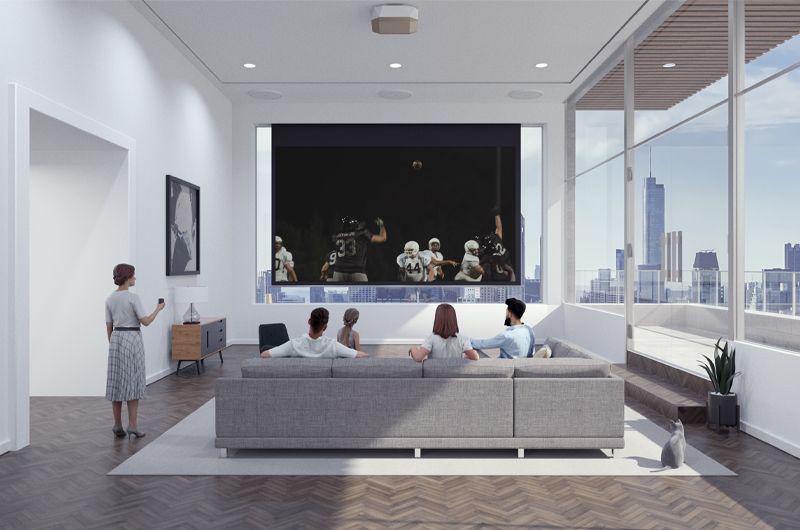
This comes at an interesting time, as the newer Digital Cinema Initiatives (DCI) Cinema HDR specification sets a peak brightness standard of 300 nits for HDR, a topic that is gaining more attention. However, it's important to consider the full specification, which not only includes a 300-nit peak brightness but also a black floor of 0.005 nits and a 60,000:1 contrast ratio. Users aiming to meet the 300-nit peak brightness can certainly achieve it with the QL7000.
The QL7000 also excels in other key areas, such as gaming performance, meeting the needs of gamers with current-generation game consoles and high-end gaming PCs. It supports 4K/120Hz gaming through two 40Gbps HDMI 2.1 ports with 10Gbps @ 4 Lanes FRL. Additionally, the QL7000 offers low input latency, which is uncommon in this class of projector.

Input latency measures 21ms at both 4K/60Hz and 4K/120Hz, slightly higher at 30ms for 1080p/120Hz, and significantly higher at 40ms for 1080p/60Hz. This makes the QL7000 suitable for casual or semi-competitive gaming at 4K. Furthermore, it supports eARC and ALLM (Auto Low Latency Mode), allowing it to automatically switch to Fast Image Processing mode for optimized gaming performance.
Several standout features of the QL7000 include the built-in web interface, which allows users to control the unit remotely through a web browser. This feature proved especially useful during calibration, as it provided full control of the projector without the need to navigate through on-screen menus with the included remote control. Notably, this web interface is available across all Q series projectors, including the QB1000.
The QL7000 also allows users to set the HDR peak brightness in the value of nits when using static tone mapping instead of dynamic tone mapping. However, the main issue with this setting is that it is too coarse, making it difficult to match the exact desired value—resulting in the output being either slightly over or under the optimal level. If this control were more granular, it would be easier to fine-tune the HDR settings precisely.
Another valuable feature is the ability to import and export batch settings. This allows users to back up the QL7000's settings to a USB drive and restore them when needed, returning the projector to its previous configuration effortlessly.
The included backlit remote provided excellent control of the QL7000, offering quick access to all features. It includes two customizable User buttons that can be assigned specific functions, such as Image Enhancement, Frame Interpolation, Content Playback, and more. Buttons with no assigned function are blacked out, which is a thoughtful design choice since they serve no purpose.
Additionally, the QL7000 supports various automation and home control systems, including Crestron and Control4, making it a valuable addition for users integrating it into a smart home setup. This integration allows users to seamlessly incorporate the QL7000 into their system and program their preferred remote exactly as desired.
Performance
Color Modes. The QL7000 offers four picture modes: Dynamic, Vivid, Cinema, and Natural. As seen in other models like the QB1000, these picture modes are shared between both SDR and HDR, meaning they do not retain separate settings based on dynamic range. As a result, any adjustments made to a picture mode will persist regardless of whether the content is in HDR or SDR, requiring users to manually switch modes depending on the content.
Additionally, the Light Output setting, which controls laser power, is applied globally across all picture modes and dynamic ranges. For example, if a user wanted a separate picture mode for SDR with specific calibration and light output settings, they would need to manually change both the picture mode and light output setting. Ideally, each picture mode would retain its own settings per dynamic range, with light output tied to individual picture modes for greater flexibility.
Currently, the Dynamic picture mode remains the only mode capable of performing a Full Fade to Black (FFTB). It would be ideal if this feature were available globally and could be enabled or disabled based on user preference.
The QL7000 provides users with extensive calibration controls for fine-tuning the image. Standard global controls include Contrast, Brightness, Color Saturation, Tint, and Sharpness. Additionally, Offset and Gain controls are available, along with 8-point Color Matching controls for adjusting color temperature and RGB balance. A complete Color Management System (CMS) is also included, allowing precise adjustments to the Hue, Saturation, and Luminance of both primary and secondary colors.
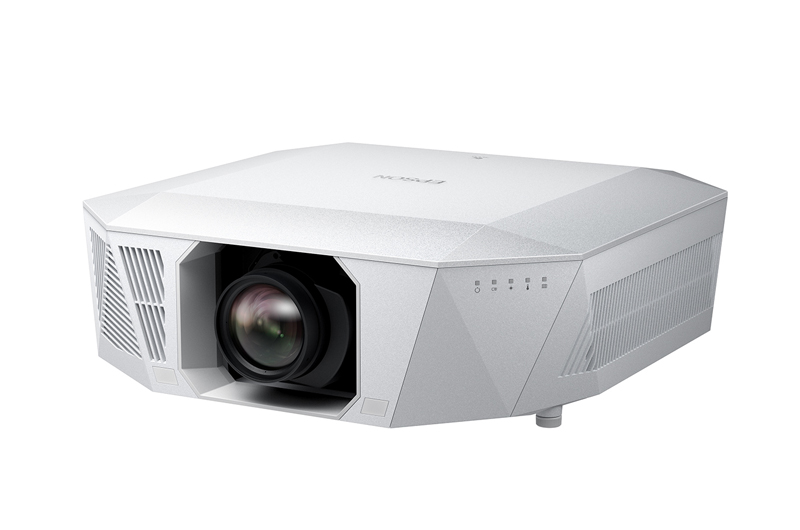
One standout feature of the QL7000 is its Color Uniformity adjustment, an excellent addition that I wish more projectors offered. This function allows users to adjust brightness levels from black to white by finetuning the red, green, and blue values between levels 2 and 8. This helps ensure uniform brightness across the entire screen.
The QL7000 also includes gamma controls, along with the custom gamma menu commonly found in Epson projectors. When set to Natural mode, the projector's gamma closely aligns with its listed targets, which use standard values such as 2.2 and 2.4. However, I found that each setting measured approximately 0.1 below its menu listing. For example, a setting of 2.4 measured at 2.3, while 2.5 measured at 2.4. Despite this minor discrepancy, the gamma remained extremely flat across all settings, which is a great result.
Out of the box, the QL7000 performed exceptionally well in the Natural and Cinema picture modes. This is typical for Epson projectors, as the Natural mode is usually quite accurate right from the start. The level of accuracy offered would satisfy many users, requiring only minor adjustments—such as turning certain features on or off—to enhance the picture to their liking.
While Dynamic and Vivid modes are not particularly accurate, they weren't overly offensive, despite a noticeable green bias. These modes had a cooler or more greenish hue, but it was not excessively exaggerated, making them viable options for calibration. In particular, Dynamic mode can benefit from calibration to take full advantage of the FFTB it offers.
For users who choose not to calibrate, I recommend starting with the Natural or Cinema picture modes while enabling Dynamic Contrast. While using Dynamic mode would provide a better overall experience, it would require users to adjust the White Balance controls—but the effort is well worth it.
I calibrated the QL7000 with Calman Ultimate calibration software from Portrait Displays, a Colorimetry Research CR-250 Colorimeter, Colorimetry Research CR-100 Colorimeter, and a a Murideo 8K Seven Generator. The QL7000 was calibrated to a 130-inch diagonal 2.35 scope screen size and a 100-inch diagonal screen size on a Stewart Filmscreen StudioTek 130 G4 projection screen. I ran my normal measurements to confirm what I saw in OOTB viewing prior to calibration.
The pre-calibration measurements for the QL7000 showed average dE errors ranging from 1.3dE to 2.3dE, with maximum errors reaching up to 3.3dE. These measurements included a grayscale of 2.3dE average and 3.2dE maximum, 5% saturation sweeps measuring 1.3dE average and 2.8dE maximum, and a large-scale color checker measuring 1.7dE average and 3.2dE maximum. HDR errors were slightly higher, averaging approximately 7dE with maximum errors upwards to 14dE, primarily due to the QL7000's limited gamut coverage.
The QL7000's gamut coverage measured 78.81% xy and 84.53% uv for DCI-P3, while BT.2020 coverage was 57.96% xy and 63.28% uv. Ideally, full P3 coverage would have been preferable, and it should be considered the bare minimum by today's standards. The QL7000's native contrast ratio measured approximately 3,400:1 FOFO in Natural picture mode; however, when using Dynamic and Dynamic Contrast modes, these numbers can easily rise to over 500,000:1.
I targeted the industry-standard D65 neutral gray white point using the Gain controls, 8-point color matching, and a full CMS calibration.
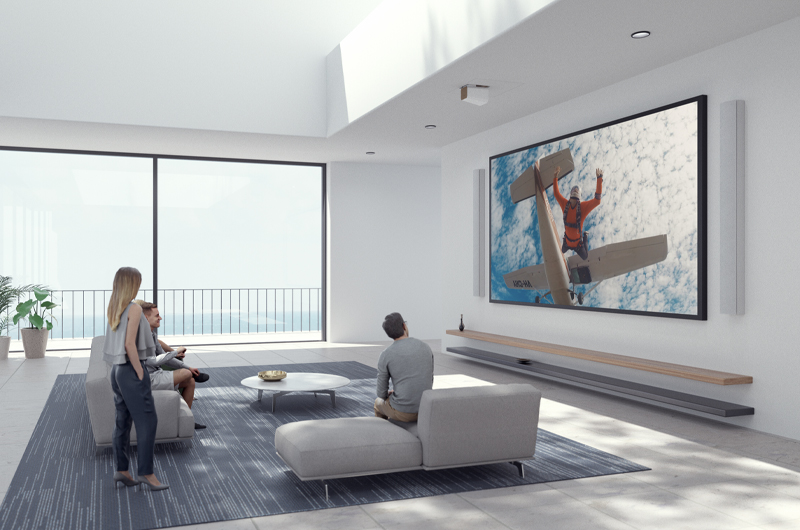
The post-calibration DeltaE errors improved for both SDR and HDR. In SDR, the grayscale average was 0.3 dE, with a maximum of 0.8 dE. A large 150+ patch color checker measured an average of 1.3 dE with a maximum of 3.2 dE. Saturation sweeps at 5% showed an average of 0.8 dE and a maximum of 3 dE. Post-calibration HDR results showed an average of 3.3 dE with a max of 7.3 dE, primarily due to gamut coverage.
The devices I used for reviewing content post calibration were an R_Volution Player One 8K media player and Kaleidescape.
1080p/SDR. The first movie I watched was The Shape of Water in SDR via the R_Volution Player One 8K Media Player. The QL7000 performed exceptionally well, delivering a sharp and clean image. It rendered colors accurately, particularly in skin tones and the overall color palette of the film.
The QL7000 also handled shadow detail effectively in scenes where shadows played a significant role, though some of this was influenced by its higher black floor due to its high brightness. However, this brightness enhanced certain scenes, such as the one in the Cadillac dealership with Strickland, where the vivid lighting and distinct car colors were beautifully rendered.
Overall, the QL7000 produced an impressive image and exceeded my expectations for SDR content, even though it was brighter than I would have preferred.
4K/HDR10. The next movie I chose to watch was Aquaman via Kaleidescape. The QL7000 performed exceptionally well under various viewing conditions, including natural light coming from the side of the room, overhead lighting, and a completely dark environment. In each of these settings, I tested the projector at both its minimum and maximum laser levels.
In brighter environments, using the maximum laser setting provided a highly watchable picture. The QL7000 produced enough light output to counteract ambient light, which would typically diminish the viewing experience on lower-lumen projectors. One standout scene was when King Orm (Ocean Master) met with King Nereus to discuss going to war. On a less capable projector in a well-lit room, the darker portions of the image would often lack detail. However, the QL7000 rendered these areas with impressive clarity.

Another visually striking moment was when Mera emerged from the water as Arthur placed his father in the truck. The bright highlights from the moonlight reflecting off the water were especially vivid. The QL7000 also delivered excellent color and a vibrant image in the subsequent scene, where Black Manta was paid by Ocean Master as the Atlantean ship appeared beneath Black Manta's submarine.
At its minimum laser power, the QL7000 also excelled, offering improved dynamic range due to a lower black floor. Overall, the QL7000 demonstrated outstanding versatility, performing exceptionally well across a range of environmental conditions.
4K/HDR. The next movie I watched was Avatar: The Way of Water via Kaleidescape. Once again, the QL7000 performed exceptionally well, showcasing its versatility throughout the film by rendering vibrant and colorful images.
One of the most striking scenes was when Jake and Spider sneaked aboard the ship to rescue Jake's daughters. The image quality was fantastic, whether at minimum or maximum laser settings. The fire burning on the ship from explosions was well-rendered, though there was some clipping. However, this did not detract from the overall impressive presentation.
Many scenes were reminiscent of watching content on a large LED display, though the experience was far more immersive due to the sheer size of the projected image. The QL7000 actually presented this movie even better at a higher laser level, particularly toward the end when Jake's son rescued him, and his daughter illuminated a path out. The increased luminance made the image more visually pleasing and impactful.
Have a Projector Question?
Join our free ProjectorCentral Facebook Group to get answers quickly.
Check it Out
4K/HDR10. The last movie I watched was Gran Turismo via Kaleidescape. The scene I revisited multiple times was the Red Bull Ring race for Jann's license. The image quality was excellent, with smooth motion during the various pans throughout the race. The highlights of the sun reflecting off the cars were bright, while the cars themselves were rendered with exceptional detail and rich color. The same was true for the track's surroundings, with the environment's colors appearing natural and well-represented. The image was consistently sharp and highly detailed.
This movie also looked impressive when viewed on the QL7000 at higher laser power. It performed well both in a dark, controlled lighting environment and in a room with ambient light, as the QL7000's high light output effectively counteracted the surrounding illumination.
Conclusion
The QL7000 is truly an impressive projector. When considering its compact size, aesthetically pleasing design (especially compared to many high-lumen projectors), interchangeable lens system, quiet operation, ability to run on a standard voltage line at full power, and, most importantly, its price, it becomes clear how much thought went into its design—and how much value it offers.
With many high-lumen projectors, users have limited options, often resorting to models designed for conference rooms and large venues, which typically compromise accuracy and picture quality. These models are often loud, generate significant heat, and sometimes require specialized power sources. Meanwhile, more cinema-focused projectors can be expensive, still have strict power requirements, and are often quite large. Comparatively, none of these drawbacks apply to the QL7000. Additionally, other projectors in this price range typically offer only a third of the light output that the QL7000 is capable of.
When considering these factors, it's evident that the QL7000 fills an important gap at a competitive price point. This projector is versatile enough to be used in a multipurpose space, such as a living room, thanks to its sleek design and high brightness, which makes it suitable for various lighting conditions.
However, as impressive as the QL7000 is, it may not be the ideal choice for everyone. Its extreme brightness might be excessive for users with smaller screens, as some may find it difficult to dim the laser to their preferred levels. Additionally, I found its gamut coverage lacking—I would have liked to see full P3 coverage, which the QL7000 falls short on. A higher native contrast would also have greatly benefited dark-room viewing. Another minor drawback is the need to remove the top cover to install the lens, whereas most interchangeable lens projectors allow for front-mounted, lock-in installations. That said, once a lens is installed, users are unlikely to swap it frequently, if at all.
Beyond these points, there is little to dislike about the QL7000. It features a smaller pixel grid than the QB1000, making it virtually invisible beyond 1 to 2 feet. It also delivers solid gaming performance, dynamic tone mapping (DTM) for HDR, and good color accuracy—all of which contribute to its exceptional value.
Users looking to illuminate larger screens or seeking higher brightness for enhanced visibility in ambient light should seriously consider the QL7000—or even the QL3000. It's an outstanding projector with excellent price-to-performance value, sure to impress anyone who sees it.
Measurements
Brightness. The Epson QL7000 is rated for 10,000 ANSI lumens. The brightest picture mode is Dynamic which measured 10,103 ANSI Lumens which is almost 1.03% higher than Epson's listed specification.
EPSON QL7000 ANSI Lumens
| SDR | LD Power 100 |
|---|---|
| Dynamic | 10,103 |
| Vivid | 8,186 |
| Cinema | 8,310 |
| Natural | 8,314 |
| HDR | LD Power 100 |
| Dynamic | 10,034 |
| Vivid | 8,206 |
| Cinema | 8,291 |
| Natural | 8,231 |
Zoom Lens Light Loss. The QL7000's light loss when shifting from the widest zoom position to its longest telephoto position was 17.15%.
Brightness Uniformity. The Epson QL7000 projecting a 100-inch diagonal image resulted in measured brightness uniformity of 83% while in wide-angle zoom, and 87% in telephoto zoom. The brightest portion of the screen was the middle center with the dimmest being the right top. The difference in brightness on a full white screen was not noticeable.
Fan Noise. Epson rates the fan noise at 26 dB in Quiet Mode, and 33 dB in Normal Mode. Using Room EQ Wizard software and a Umik-1 microphone, my theater room ambient noise floor is 33.3 dBA. What follows are the dBA levels I measured from the QL7000 at three different laser power settings from three feet away and from the four different sides of the projector. The Epson QL7000's highest audible noise starts after increasing the laser from approximately 85% to 100%.
ECO 30% laser
Front: 34.9 dBA
Right: 35.5 dBA
Left: 34.5 dBA
Rear: 34.9 dBA
65% laser
Front: 38.9 dBA
Right: 39.7 dBA
Left: 37.6 dBA
Rear: 37.3 dBA
100% laser
Front: 40.3 dBA
Right: 40.8 dBA
Left: 38.3 dBA
Rear: 37.5 dBA
Input Lag. Input lag measurements were done using Fast Image Processing.
1080p/60Hz = 40ms
1080p/120Hz = 30ms
4K/60Hz = 21ms
4K/120Hz = 21ms
Connections
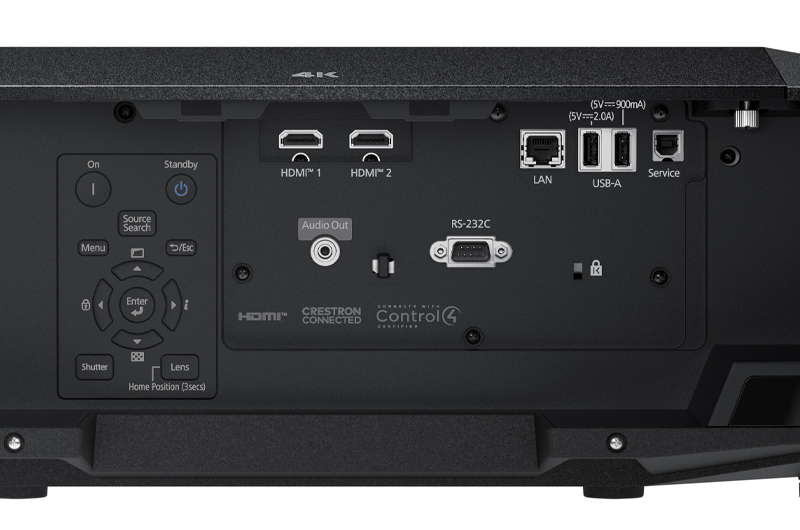
- HDMI 2.1 (x2; HDCP 2.3; 40Gbps FRL: 10G@4L; eARC support)
- RJ45 LAN 100 base Tx (control only)
- USB 2.0 Type A (5V, 0.9A max power delivery; firmware update; media playback)
- USB 2.0 Type A (5V, 2.0A power delivery; firmware update; media playback)
- USB Type B (service only)
- RS232 (x1)
- 3.5mm stereo jack (x1)
- 12V DC Trigger
Final Settings
Calibrated image settings from any third-party do not account for the significant potential for sample-to-sample variation, nor different screen sizes and materials, lighting, lamp usage, or other environmental factors that can affect image quality. Projectors should always be calibrated in the user's own space and tuned for the expected viewing conditions. However, the settings provided here may be a helpful starting point for some. Always record your current settings before making adjustments so you can return to them as desired. Refer to the Performance section for some context for each calibration.
SDR Settings
Light Output: 30%
Color Mode: Natural
Brightness: 50
Contrast: 50
Color Saturation: 50
Tint: 50
Sharpness
Standard: 3
Thin Line Enhancement: 1
Think Line Enhancement: 1
White Balance
Color Temp: 6500K
G-M Correction: 3
Custom
Offset R: 50
Offset G: 50
Offset B: 50
Gain R: 45
Gain G: 50
Gain B: 48
Color Matching
| Adjustment Level | Red | Green | Blue |
|---|---|---|---|
| Adjustment Level 8 | -2 | 0 | -0 |
| Adjustment Level 7 | 1 | 0 | 0 |
| Adjustment Level 6 | 1 | -1 | -1 |
| Adjustment Level 5 | 1 | -3 | 0 |
| Adjustment Level 4 | 0 | -4 | 0 |
| Adjustment Level 3 | -1 | -4 | 2 |
| Adjustment Level 2 | 0 | 0 | 0 |
| Adjustment Level 1 | 0 | 0 | 0 |
Image Enhancement: Off (User Preference)
Advanced
Scene Adaptative Gamma: Off (User Preference)
Gamma: 2.5
Color Management
| Color | Hue | Saturation | Brightness |
|---|---|---|---|
| Red | 53 | 50 | 50 |
| Green | 51 | 55 | 45 |
| Blue | 43 | 53 | 50 |
| Cyan | 51 | 54 | 50 |
| Magenta | 51 | 46 | 50 |
| Yellow | 46 | 51 | 50 |
Dynamic Contrast
Dynamic Contrast: On
Response Speed: High Speed
Black Level: 0%
HDR
Light Output: 30%
Color Mode: Dynamic
Brightness: 50
Contrast: 50
Color Saturation: 50
Tint: 50
Sharpness
Standard: 2
Thin Line Enhancement: 2
Think Line Enhancement: 2
White Balance
Color Temp: 7500K
G-M Correction: 9
Custom
Offset R: 50
Offset G: 50
Offset B: 50
Gain R: 50
Gain G: 27
Gain B: 27
Color Matching
| Adjustment Level | Red | Green | Blue |
|---|---|---|---|
| Adjustment Level 8 | 0 | 0 | 0 |
| Adjustment Level 7 | 0 | 0 | 0 |
| Adjustment Level 6 | 0 | 0 | 0 |
| Adjustment Level 5 | 0 | 0 | 0 |
| Adjustment Level 4 | 0 | 0 | 0 |
| Adjustment Level 3 | 0 | 0 | 0 |
| Adjustment Level 2 | 0 | 0 | 0 |
| Adjustment Level 1 | 0 | 0 | 0 |
Image Enhancement: Off (User Preference)
Advanced
Dynamic Tone Mapping: On
Scene Adaptative Gamma: (User Preference)
Gamma: 0
Color Management
| Color | Hue | Saturation | Brightness |
|---|---|---|---|
| Red | 50 | 33 | 50 |
| Green | 50 | 50 | 50 |
| Blue | 62 | 36 | 50 |
| Cyan | 43 | 50 | 50 |
| Magenta | 29 | 36 | 50 |
| Yellow | 55 | 48 | 50 |
Dynamic Contrast
Dynamic Contrast: On
Response Speed: High Speed
Black Level: 0%
For more detailed specifications and connections, check out our Epson QL7000B projector page.
To buy this projector, use Where to Buy online, or get a price quote by email direct from Projector Central authorized dealers using our E-Z Quote tool.







